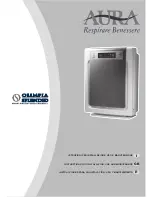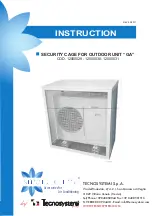
26
Water Cooled Package
Installation
- Chassis Installation
1. Connect water coil pipe to the system with a flexible steel hose assembly.
2. Verify that the shut-off/balancing valve in the return line/supply line are closed.
3. Place shut-off valves in appropriate location (see sticker on the equipment for best placement
recommendation) to allow chassis to slide easily in/out of unit cabinetry.
4. Flush system. See Cleaning and Flushing the Water Loop for flushing instructions.
5. Open the unit water valves and check piping for leaks.
6. Connect electrical to unit chassis via the quick connect mating plugs.
Four plugs are included (motor, optional condensate overflow, power and thermostat).
7. Slide chassis into the cabinet. Center the chassis left to right to minimize sound transmission.
8. Verify unit's air filter is properly place in the chassis filter rack.
9. Install cabinet's front cover to the hinged door.
10. Ensure the gasket material creates a positive seal around the entire coil to avoid coil bypass. If a field
supplied door is used, ensure the front cover is attached to the building structure and not the unit
cabinet.
- Supply Grille Installation
1. Install the supply grille(s) into the cabinet discharge opening. Insure there are no air gaps between
thecabinet supply air and the grille. This helps prevent recirculation of supply air into the return air
opening behind the drywall.
2. Secure grille(s) into the drywall via two screws.
- Cleaning and Flushing the Water Loop
1. After the piping system is complete, the flexible hose connectors should be doubled back to complete the
water circuit external to the unit (avoiding trash settle-out in the condenser). An extra pipe may be
necessary to connect the hose kits. See next page for antifreeze/water mixture by volume.
2. Water circulation system should be filled with clean water using the water make up connections.
Air vents should be opened during filling.
3. With the air vents closed, start the circulating pump and then crack the air vents to bleed off the trapped
air, assuring circulation through all components of the system.
Make up water must be available to the system to replace the volume formerly occupied by the air that is
bled off.
4. With the air vented and the water circulating, the entire system should be checked for leaks with repairs
made as required.
5. Operate the supplementary heat system making checks per manufacturer's instructions. During this
operation, visual checks should be made for leaks that may have occurred due to increased heat. Repair
as required.
6. Open the system at the lowest point for the initial blow down (making sure the make up water is equal to
the water being dumped). Continue blow down until the water leaving the drain runs clear, but not less
than 2 hours.
NOTE
NOTE
NOTE
Содержание AKWW0093AA0
Страница 29: ...P No MFL30215306 ...




































